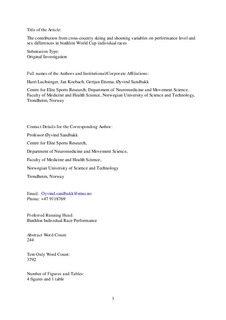The Contribution From Cross-Country Skiing and Shooting Variables on Performance Level and Sex Differences in Biathlon World Cup Individual Races
Journal article, Peer reviewed
Accepted version

Åpne
Permanent lenke
http://hdl.handle.net/11250/2595424Utgivelsesdato
2018Metadata
Vis full innførselSamlinger
Originalversjon
10.1123/ijspp.2018-0134Sammendrag
Biathlon is an Olympic winter sport that combines rifle shooting and cross-country skiing in various race formats. In the individual distance (15 km for women and 20 km for men), athletes compete over 5 laps of skiing with shooting between each 2 laps (ie, 4 shootings). The aim of the current study was to compare total race time differences, as well as the contribution from cross-country skiing and shooting variables to this difference, between biathletes of different performance levels and sexes in individual races in the Biathlon World Cup. Based on the publicly available race reports, the authors compared these factors between top-10 results (G1–10) and results within rank 21–30 (G21–30), as well as the corresponding sex differences. G21–30 among men/women were on average 4%/6% behind G1–10 in total race time, in which course time accounted for 42%/54% of the overall performance difference, followed by 53%/44% explained by penalty time caused by shooting performance (ie, the number of hits). The remaining 2–3% was explained by differences in shooting time and range time. Women G1–10 were on average 15% slower in skiing speed than men G1–10, which accounted for 92% of the overall performance difference between sexes. In total, among G1–10, men shot on average 15 s faster than women, and total penalty time was 18 s shorter. In conclusion, course time and penalty time contributed approximately equally to the performance-level differences, whereas course time explained above 90% of the sex differences in individual World Cup biathlon races.